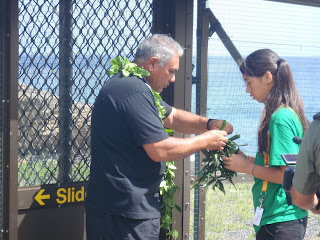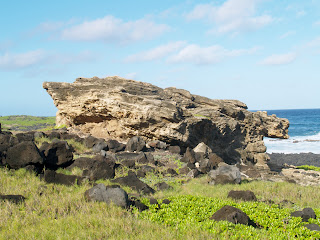The day after Wai'anae High's hike it was Kamaile Academy's turn. Mr. Ferenchak and Mr. Nakashima arranged to have all of the ninth graders go on the hike. Several chaperones and kupuna also joined us. Our first stop was at the raised coral reef formations near the trailhead.
We learned about a place called Kilauea. When the ocean is rough, this area can be particularly dangerous. We learned to respect nature and always be aware of what is around us.
The recent rains have made the plants look healthy again. Here is the pa'u o Hi'iaka, the skirt of Hi'iaka in bloom.
Can you see evidence of the railway that once ran along this trail and all the way around Ka'ena Point?
We finally made it to the Point after about an hour and a half of hiking. We were treated by a special encounter with two scientists with an albatross in hand! They were tagging this bird so that they could track its movement from Ka'ena Point to wherever it goes. Laysan albatrosses are known to go to Kaua'i and even as far as Japan and Alaska. They can fly non-stop for thousands of miles just to get food to bring back to feed their mates and babies.
We also learned that their wing spans could be 6-7 feet and that they can lock their wings so that they can glide when there's a strong wind.
As we listened to Uncle Keale (sorry no photos), we rested and contemplated the long hike back in the hot, hot sun! Good thing we brought extra water.
We walked around the perimeter of the predator-proof fence on the way back and got a good idea of what the area will be like when full restoration starts taking place. The fence is not completed yet but when it is, the area will be on its way to be free from non-native predators, and the birds and plants will be safe.
Here we are getting ready to make the journey back . . . another two miles! Do we look ready? Of course!
For some people, the hike back seemed shorter. But for others, it was like the trail got longer!
It felt great to sit down again in the bus. Mahalo to everyone who helped make this field trip happen!













































